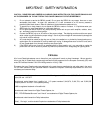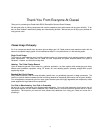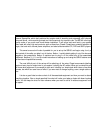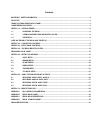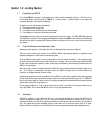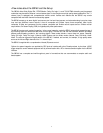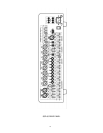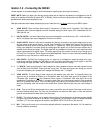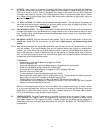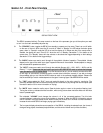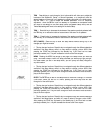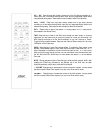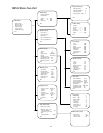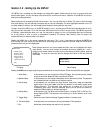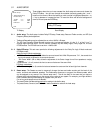
10
2.2 OUTPUTS: Video outputs for Component, Composite and S-Video formats are provided. Both the Composite
and S-Video formats have outputs with On Screen Display (OSD) and without On Screen Display (NO OSD). The
OSD can be turned off and on. There is a Composite video output for the remote Zone and both S-Video and
Composite video outputs for recording. The S-Video inputs also deliver Composite video output signals. (S-Video
In to S-Video Out will deliver higher quality video). Both analog audio outputs and a digital audio output are
provided from the SSP-60.
2.2.1 7.1 AUDIO OUTPUTS: The SSP-60 has both balanced and single ended 7.1 channel outputs. They deliver both
stereo and multi-channel signals, depending on the source signal and the mode of playback you select. If you
only have one rear speaker use the left SURR REAR 7.1 output.
2.2.2 DIGITAL AUDIO OUTPUT: The Optical digital output (TOSlink) delivers the same digital audio information that
is present at the digital input of the selected source. Analog information will not be converted to digital for output
here. This digital signal can be routed to another surround processor, digital recorder or to a high-quality digital-
to-analog converter (DAC).
2.2.3 REC AUDIO OUTPUTS: There are three record audio outputs. They all carry the analog audio of the currently
selected main Source (NOT the zone source or the PLAY input). Digital Inputs are not decoded through these
outputs.
2.2.3.1 When deciding what input and output cable combinations you will need, you have to first decide how you will be
using the processor. If you use the Remote Zone you can have two sources, each playing in a separate area.
However, you cannot record one source while watching another, unless you use the Remote Zone output as a
tape out. Be aware that to record a Satellite feed when you are listening to a decoded digital signal in the main
area, you must have the analog audio and composite video signals from the Satellite receiver connected to the
corresponding AV and composite video inputs.
FOR EXAMPLE:
• Digital audio from the Satellite Receiver is plugged into COAX1
• COAX1 is assigned to AV1
• Analog two-channel audio output from satellite receiver is plugged into AV1 analog inputs
• S-Video from the Satellite receiver is fed to VID1 S-Video input
• Composite video from Satellite Receiver is plugged into VID1 Composite video input
• Select AV1 as source for Main area
• 7.1 Main outputs will contain decoded digital audio from COAX1
• Record outputs will contain signal only from analog inputs on AV1. The Zone output could also carry the AV1
analog signal, but only if AV1 is selected as the source signal for Zone.
• S-Video output from AV1 appears on S-Video OSD and NO OSD and on S-Video REC out.
• Composite Video from AV1 appears on Composite OSD and NO OSD, plus the REC and Zone Composite
outputs (if Zone has AV1selected as its source).
With only a little thought and planning you can turn the SSP-60 into a versatile control center. To record a source,
or to play music throughout your house you will need to connect both the digital and the analog inputs from
several audio or audio video pieces, such as a CD player, a Satellite receiver or a DVD player. Refer to Section
6.0 for more information on using the tape inputs and outputs.
2.3 TRIGGER OUTPUTS: The three Triggers give you a great deal of control over your total system. Trigger 1 may be
set up separately from Triggers 2 and 3. The triggers may be individually set up to enable and disable various
other system components. The Triggers only deliver a control voltage, but the delivery can be configured in
several ways to allow you to properly signal equipment to turn off and on. See Section 5.5: TRIGGER SETUP for a
full explanation.



